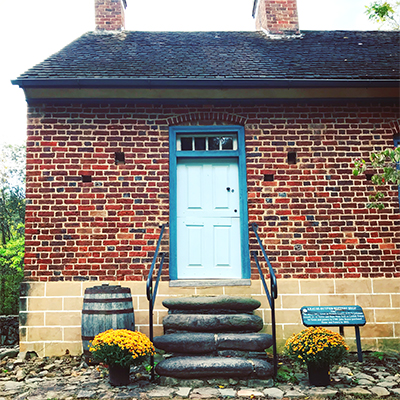The Potter’s House
1754 Reconstructed Village | The Palisade | The Log House | The Brewer’s House | The Potter’s House | The Gemeinhaus

“People gathered from 50 and 60 miles away to buy pottery, but many came in vain, as the supply was exhausted by noon. We greatly regretted not being able to supply their needs.”
— Bethabara Diary, June 15, 1761
Built in 1782, the Potter’s House is the oldest brick house in Forsyth County. It was built by Johannes Schaub, the town’s dyer. Seven years later, Johann Gottlob Krause, one of Bethabara’s potters, took up residence. He lived and worked here for 13 years, using a kiln to fire pottery. When the Buttner family arrived in 1802, they continued the pottery tradition, using the same kiln. The legacy of Buttner and Krause give this house its name.
The Pottery Tradition at Bethabara
Bethabara is the site of the first European pottery kiln in North Carolina. The arrival of Gottfried Aust in 1755 to Wachovia brought the much-needed craft of pottery-making to Wachovia. Taking advantage of an abundant supply of clay in the Bethabara area, Brother Aust supplied lead-glazed earthenware pottery-not only to the households of the Moravians in Bethabara, but also to many of the settlers in a fifty- to sixty-mile radius. According to archaeological excavations, thirty-five different pottery forms were being made in Bethabara by Aust and his associates from 1756 to 1771. Because of the threat of attack during the French and Indian War, Aust’s pottery shop was situated inside the walls of the Palisade fort during its first 7 years. After the fort was torn down, the pottery building was expanded. When Aust moved to Salem in 1771, the pottery was dismantled and transferred with him. For fifteen years thereafter, there was no pottery in Bethabara.
In 1786, Aust’s apprentice, Rudolph Christ, persuaded the Collegium in Salem to allow him to establish, once again, a pottery in Bethabara. Christ was interested in making Queensware, also known as “fine pottery.” Aust and Christ had learned how to produce the English-style pottery in Salem in 1773-74 from a traveling potter named William Ellis. From 1786 to 1789, Brother Christ ran a pottery in the old smithy in Bethabara. After the death of Aust in 1789, Christ moved back in Salem to direct the pottery there.
Gottlob Krause, a former apprentice of Aust in Salem, them became the master potter in Bethabara. While master, Krause made the same kind of earthenware pieces that Aust had produced. It is believed that Krause was dissatisfied with the pottery building where the house of Johannes Schaub, Jr., the dyer, which had been built in 1782. Krause was probably in the house, known now as the 1782 “Potter’s House,” from 1789 until he died in 1802.
John Butner, a former apprentice of Christ’s in Salem, took over the pottery in 1802. After the demise in 1801 of the Oeconomie-Bethabara’s economic system in its early days (records are less substantial), it is believed that John Butner, and later his son Joseph, ran a pottery out of the 1782 building between 1802 and 1872.
The Provincial Elders’ Conference of the Moravian Church, Southern Province, purchased the Potter’s House from Clyde Shore in 1957. The house was restored to its current state in the mid 1970s.
Archaeology
The Krause-Buttner kiln was excavated by Stan South and J. Glenn Little, II in 1966. Archaeologists discovered the kiln behind the Potter’s House after digging an exploratory trench, where they uncovered a kiln and dark brown slipped pottery made by Krause and Buttner. The most significant archaeological find related to pottery at Bethabara was the discovery of Gottfried Aust’s kiln and pottery shop inside the palisade fort. Want to see real artifacts made by Bethabara’s potters? Check out our pottery exhibit in the Visitor Center.
